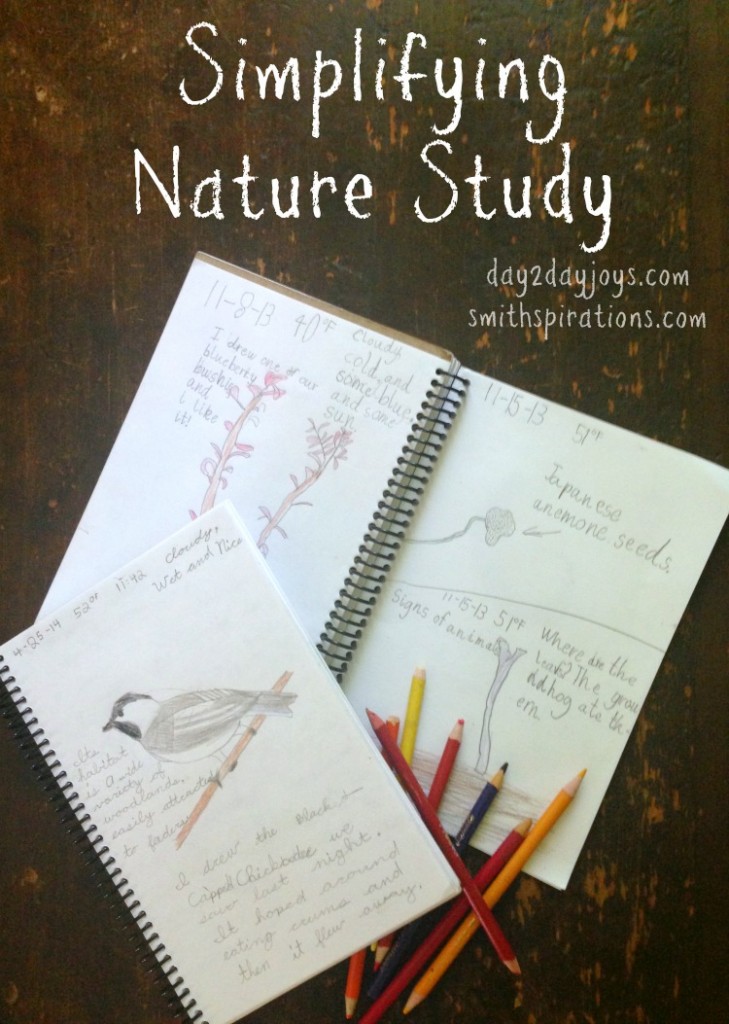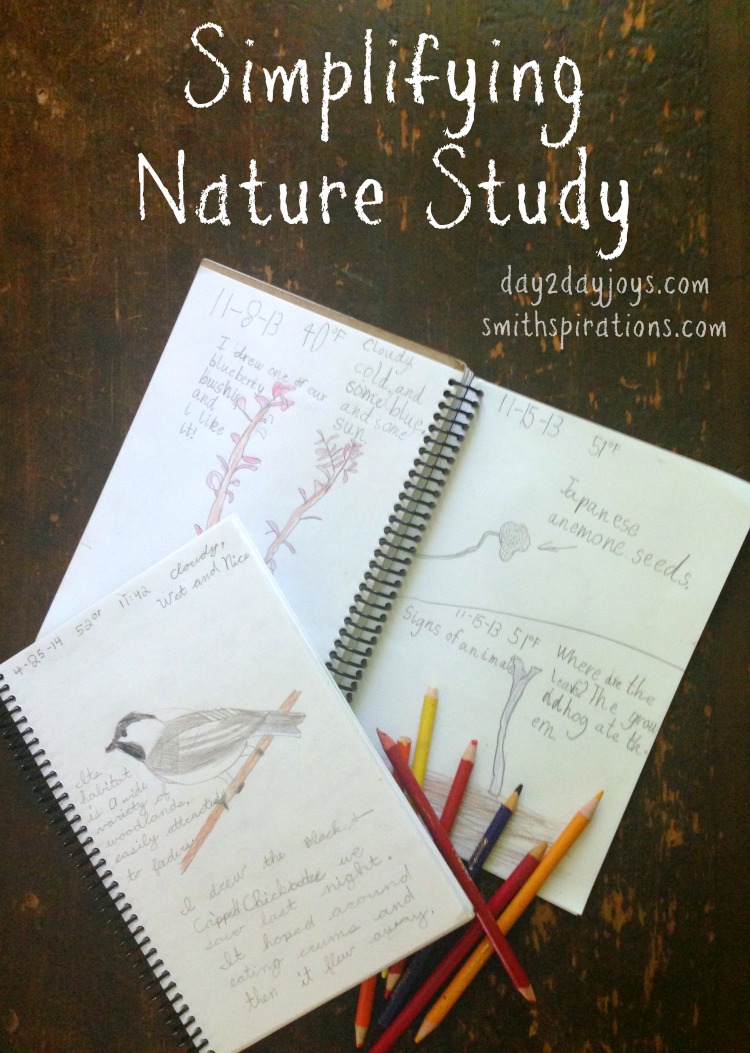The post Simplifying Nature Study appeared first on Day2Day Joys.
]]>*note from Rachel: Kristen first started contributing in May of last year. She’s talked about homeschooling (a topic she loves!), freezing blueberries, organization and more! Today she’ll be sharing her last post here. I’m sad to see her go, she’s on to new endeavors and focusing on her family. I I have been blessed by Kristen and hope you have as well!!
After researching homeschooling options and approaches years before we actually started formal education (yes, I tend to over-research), I knew that I wanted our homeschool to be focused more on hands-on experiences and less on textbooks.
When it comes to science, a hands-on approach often involves nature study. I’m someone who likes to tinker in gardening, foraging, and herbs, so nature study seemed like a great fit for us!

However, during our first couple of homeschooling years, I consistently found myself feeling overwhelmed, lost, and really uncertain with the whole area of nature study. I was never quite sure if I was doing it the right way and our projects took twice as long as I thought they should.
Looking back with a little more experience under my belt, I realize that I made nature study way more complicated than it needed to be.
Nature study can be as simple as spending time outside, finding something interesting, recording it with drawings and words in a notebook, and perhaps researching it later. Sure, you can make it more involved, but if you’re not quite sure how to tackle the whole process, those simple steps are the best place to start.
Whether your children are homeschooled or attend school, adding some nature study to your schedule is a great way to learn about God’s great creation. Keep in mind these following tips to make sure it is an enjoyable experience for you and your children.
Go With The Seasons
The seasons offer us a very simple way to organize our nature study lessons:
- In the winter, we look for animal footprints in the snow or stick with basic science experiments inside.
- In the spring, we study tree buds swelling, signs of the new season starting, and animal tracks left in the mud.
- In the summer, we watch butterflies, birds, and insects in the garden, talk about helpful plants, and identify bird calls.
- In the fall, we compare seed shapes, examine abandoned nests, and do leaf rubbings (of course!).
Let Nature Come to You
While field trips to nature parks, zoos, aquariums, and museums are fantastic ways to enrich nature study, so much can be done in our backyards!
Just a simple walk through the yard offers an abundance of plants to be discovered, and many of them are edible or useful. Clouds can be studied, bird feeders set up, and earthworms unearthed all from the comfort of the backyard. Doing nature study right at home helps keep things simple and doable!
Follow Their Interests
Sometimes I suggest a topic to study for our nature study time and my children are less than thrilled. Rather than make it an area of contention, I ask them for their input based on what is available to us that season.
I also try to keep in mind if something has recently grabbed my children’s interest. For example, when we had a groundhog lurking in our backyard, we did a couple of nature study lessons on groundhogs!
Stocking a Nature Study Tool Chest
You really don’t need many special tools for nature study, but certain materials will make the process more exciting and educational for your children. I like having these simple materials on hand:
- Inexpensive blank spiral sketchbooks serve as nature study journals
- Colored and graphite pencils are used for nature journal entries
- Magnifying glasses help see simple details and are just plain fun to use
- Simple microscopes show smaller details but are easy on the budget
- Binoculars allow us to observe animals up in trees or off in a field
Keep Some Good Nature Guides on Hand
Nature guides are our go-to when doing nature study! In fact, we have a fabric bag that we keep stocked for our nature study time that holds nature study journals, pencils, and a big stack of small nature guides. When we do nature study, the bag comes along, and so much information is right there with us!
My top suggestion for finding nature guides is to check with your state’s department of natural resources. In Ohio, I can write in for free nature study guides sent right to me as a home educator! We rely heavily on these, as well as other resources from the department.
This book (affiliate link) provides a lot of basic information that will apply to most of the Unites States. We also keep it in our handy nature study bag so it’s always with us when we head out.
Take advantage of these summer months with some simple nature study with your children!
Do you do nature study with your children? What tips do you have?
The post Simplifying Nature Study appeared first on Day2Day Joys.
]]>The post Nature Notebook for Kids appeared first on Day2Day Joys.
]]>
Written by Jenn, Contributing Writer
As the summer heat dies down and hints of fall are in the air, exploring the outdoors with the littles again becomes one of my favorite activities. The room to run and endless supply of objects to investigate always makes for a enjoyable outing.
In a beloved book on education, the author remarks that as we explore the natural world, “we are observing God’s handiwork. And it is spine-chillingly wonderful.”
This is the perspective I want to cultivate in my children, even if at one and three they simply enjoy digging in the dirt, picking flowers, and shouting about seeing the moon. “IT’S THE MOON, MOMMY! THE MOON! LOOK–IT’S SO BIG!”
Studying in greater depth will come later; for now I will do as 19th century British educator Charlotte Mason would suggest and just “involve them directly with the world, letting them enjoy, wonder, and question.”
With all of this in mind, we take our fair share of nature walks. Recently, I got all Charlotte Mason and decided we needed to preserve the bounty collected on these trips.
Making a real nature notebook might be a bit beyond my 3 ½ year old. But as I enjoy this sort of thing as much or more than her, I’m willing to endure a little glue mess and broken pressed flowers in the name of identifying and appreciating the flora in our little neck of the woods.
Frankly, I could probably do to say “yes” to a little more mess in our lives anyway. Which is why I encouraged the use of glitter in decorating our nature journal.
Making a Nature Notebook
Supplies:
Notebook with unlined pages
Paper towels
Heavy books
Basic Elmer’s glue or wood glue
Colored pencils/pens/crayons
Bits of nature
How To
1.) Go on a nature walk. Take it slow. Keep your eyes wide open.
City-dweller with not much nature to speak of? Find a pretty park or take a short drive to find a little more green space. You don’t need expansive forests and fields of flowers to make it an enjoyable experience of creation.
I had to force myself to slow down and let my daughter pick dandelion after dandelion. “LOOK MOMMY! ANOTHER YELLOW FLOWER! SO PRETTY!” What can I say? She has a zest for life.
2.) Point out all the plants and creatures.
Overlook the construction, stoplights, cars, and houses. Look for what man didn’t create.
Trees, rocks, flowers, grasses, bugs, and small critters abounded. We threw rocks in the stream and ran squealing from hoards of grasshoppers in the tall prairie grasses.
3.) Let the littles pick their favorite flowers and leaves.
Ask them questions about what they see and help them find adjectives to describe their treasures.
Yes, that one has red berries. Yes, so pretty. No, don’t eat them. Or give them to your brother. I know he wants them, but he’ll just eat them/put them up his nose. Actually, it’s probably best that you don’t touch them. Here, give it to Mommy.
3.) Bring the bounty home to press.
Put the flowers and leaves between paper towels and carefully place them between the pages of a large book. Stack more books, canned goods, hand weights, etc. on top.
4.) Wait a few days for everything to flatten and dry.
I’ve read that it can take up to a few weeks for flowers to completely dry (and that you should change out the paper towels every few days), but our flowers were small and starting to dry out in the late summer heat anyway. It only took a couple days for them to flatten and dry.
5.) In the meantime, decorate a notebook.
I covered the front of ours so that my little big girl would have blank slate to decorate.
This is where I used glitter as a tool to combat my fear of mess. It was only somewhat effective.
6.) Glue the flowers and leaves into the notebook.
I advise using small drops of glue so you can do more pages at a time. We followed the “more is always better” philosophy on page one and had to wait a good hour to continue. The final results weren’t quite as lovely as these, but they served our purposes just fine.
7.) Identify and label each flower/leaf.
We picked up this helpful book from the library to guide us. But, being committed to accurate flower identification, I may also have consulted to internet to confirm my guesses.
8.) For further study:
Older kids or even eager young ones could write (or dictate) descriptions of their findings or a short poem about what they saw on their walk. I love Kristen’s free printable nature journal pages and accompanying poetry lesson idea.
What are your favorite outdoor activities now that summer is fading?
*this post is linked to: Encourage One Another, Titus 2sdays, and WFMW*
The post Nature Notebook for Kids appeared first on Day2Day Joys.
]]>








